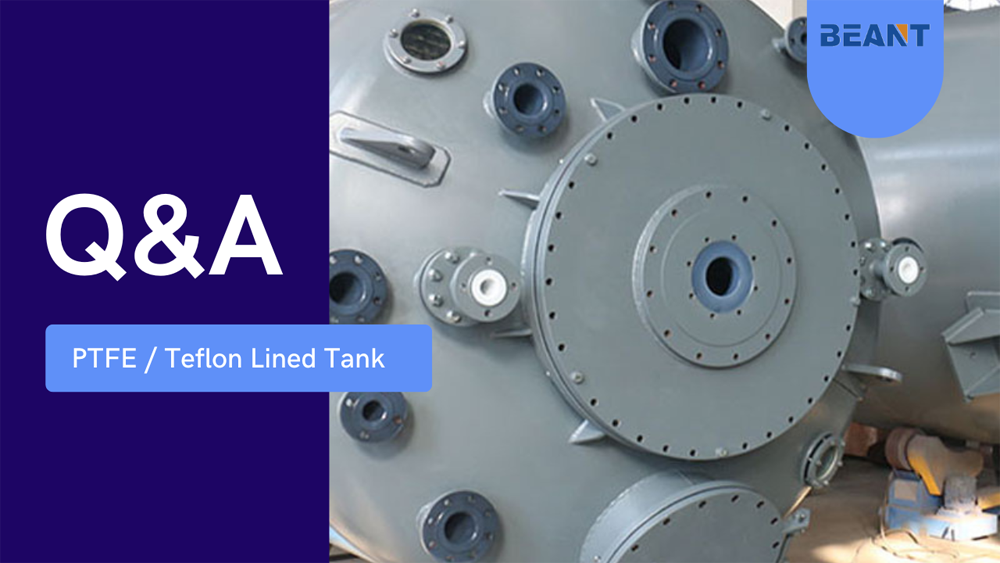
PTFE (Polytetrafluoroethylene), commonly known by the brand name Teflon, is renowned for its exceptional chemical resistance and non-stick properties. PTFE/Teflon lined tanks leverage these properties to offer robust solutions for storing and handling corrosive and reactive chemicals. These tanks are integral to various industries, ensuring safe and efficient processes where traditional materials would fail. This FAQ aims to address common questions about PTFE/Teflon lined tanks, providing insights into their features, applications, and maintenance.
A PTFE/Teflon lined tank is a storage container lined with a layer of PTFE or Teflon material. This lining is applied to the interior surfaces of the tank to provide a protective barrier against corrosive substances. The primary purpose of this lining is to ensure that the stored chemicals do not react with the tank material, thereby preventing contamination and extending the tank's lifespan.
PTFE/Teflon lined tanks offer several advantages:
1.Corrosion Resistance: PTFE/Teflon is highly resistant to a wide range of chemicals, including acids, bases, and solvents. This makes these tanks ideal for storing aggressive chemicals that would corrode other materials.
2.Non-stick Properties: The non-stick nature of PTFE/Teflon prevents the adherence of materials to the tank walls, facilitating easier cleaning and maintenance.
3.Temperature Tolerance: PTFE/Teflon can withstand a broad range of temperatures, making these tanks suitable for both high and low-temperature applications.
4.Durability: The inert nature of PTFE/Teflon ensures long-term durability and reduces the need for frequent replacements.
PTFE/Teflon lined tanks are utilized across various industries, including:
1.Chemical Processing: For storing highly corrosive and reactive chemicals.
2.Pharmaceuticals: To prevent contamination and ensure the purity of ingredients.
3.Food and Beverage: Where hygiene and non-reactivity are crucial.
4.Petrochemicals: For handling aggressive and volatile substances.
5.Water Treatment: For managing aggressive cleaning agents and chemical additives.
The manufacturing of PTFE/Teflon lined tanks involves several steps to ensure the quality and integrity of the lining:
1.Preparation: The base tank, usually made of steel or another robust material, is prepared by cleaning and roughening the interior surfaces to ensure proper adhesion of the PTFE/Teflon lining.
2.Lining Application: The PTFE/Teflon material is applied to the tank's interior surfaces. This can be done using various techniques such as sheet lining, rotational lining, or spray coating, depending on the tank's size and design.
3.Curing: The lined tank is then subjected to a curing process to bond the PTFE/Teflon to the base material. This may involve heating to specific temperatures to achieve optimal adhesion.
4.Quality Control: The lined tank undergoes rigorous quality checks to ensure there are no defects or weak points in the lining. This includes visual inspections, thickness measurements, and pressure tests.
Proper maintenance and regular inspections are crucial to extend the lifespan of PTFE/Teflon lined tanks:
1.Routine Cleaning: Regular cleaning prevents the buildup of residues and ensures the non-stick properties are maintained.
2.Visual Inspections: Frequent visual checks help identify any signs of damage or wear early on.
3.Non-destructive Testing: Techniques such as ultrasonic testing can detect hidden defects in the lining.
4.Repair Procedures: Minor damages can often be repaired on-site, while severe issues may require professional re-lining services.
PTFE/Teflon lined tanks are characterized by:
1.High Chemical Resistance: Suitable for a wide range of aggressive chemicals.
2.Temperature Stability: Functional across a broad temperature range, typically from -200°C to +260°C.
3.Non-stick Surface: Facilitates easy cleaning and prevents material buildup.
4.Low Friction Coefficient: Reduces wear and tear on the lining material.
5.Customization: Available in various sizes and shapes to meet specific industry requirements.
While PTFE/Teflon lined tanks are highly durable, they can encounter issues:
1.Lining Delamination: Caused by improper bonding or exposure to extreme conditions. Regular inspections can prevent this.
2.Mechanical Damage: Abrasive materials or improper handling can cause scratches or gouges in the lining. Implementing protective measures during use can mitigate this risk.
3.Chemical Attack: Although rare, certain aggressive chemicals might degrade the PTFE/Teflon over time. Choosing the right grade of PTFE/Teflon for specific chemicals can prevent this.
1.What are the temperature limits of PTFE/Teflon lined tanks?
PTFE/Teflon lined tanks typically operate effectively between -200°C and +260°C, making them suitable for a wide range of applications.
2.How resistant are PTFE/Teflon lined tanks to chemicals?
They offer exceptional resistance to most chemicals, including acids, bases, and solvents. However, some highly aggressive chemicals may require specific grades of PTFE/Teflon.
3.What are the typical sizes and capacities available?
PTFE/Teflon lined tanks come in various sizes, ranging from small laboratory-scale tanks to large industrial storage tanks. Custom sizes can also be manufactured to meet specific needs.
4.How long do PTFE/Teflon lined tanks typically last?
With proper maintenance, these tanks can last for many years, often outlasting tanks made from other materials.
5.Are PTFE/Teflon lined tanks suitable for food and beverage industries?
Yes, the non-reactive and non-stick properties of PTFE/Teflon make them ideal for applications requiring high hygiene standards.
6.What is the cost range for PTFE/Teflon lined tanks?
The cost varies depending on the size, design, and specific requirements. Generally, PTFE/Teflon lined tanks are more expensive than unlined tanks due to the advanced materials and manufacturing processes involved.
7.How do PTFE/Teflon lined tanks compare to other types of lined tanks?
PTFE/Teflon lined tanks offer superior chemical resistance and durability compared to many other lining materials. However, they can be more expensive and may have specific temperature limitations.
8.Can PTFE/Teflon lined tanks be repaired if damaged?
Yes, minor damages can often be repaired on-site using patch kits or professional repair services. Major damages may require re-lining.
9.What are the shipping and installation considerations?
PTFE/Teflon lined tanks require careful handling during shipping and installation to avoid damage to the lining. Proper support and protection during these processes are essential.
10.Are there any environmental concerns with using PTFE/Teflon lined tanks?
PTFE/Teflon itself is chemically inert and poses minimal environmental risks. However, the manufacturing and disposal processes should be managed responsibly to minimize environmental impact.
PTFE/Teflon lined tanks represent a critical component in the storage and handling of corrosive and reactive chemicals. Their unique properties, including exceptional chemical resistance, temperature tolerance, and non-stick characteristics, make them indispensable in various industries. By understanding the features, benefits, and maintenance requirements of PTFE/Teflon lined tanks, businesses can ensure safe, efficient, and long-lasting storage solutions.
Feel free to leave your message on our board. If you're looking to inquire about prices or place an order, this is the right place! Let us know the details of your needs, and our team will get back to you with a personalized quote as quickly as possible. We're here to ensure your experience is seamless and satisfactory. Share your requirements or ask any questions you might have - we're eager to assist and look forward to doing business with you!
Name:Tim
Phone:+86-15716151880
Email:[email protected]
Company:BEANT
Address:No. 28, Luoshen Road, Luoshe Town, Huishan District, Wuxi City, Jiangsu Province
